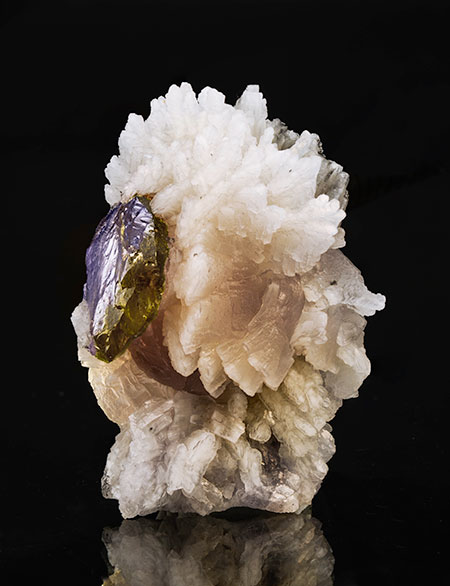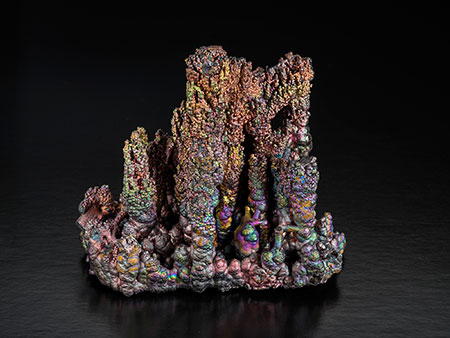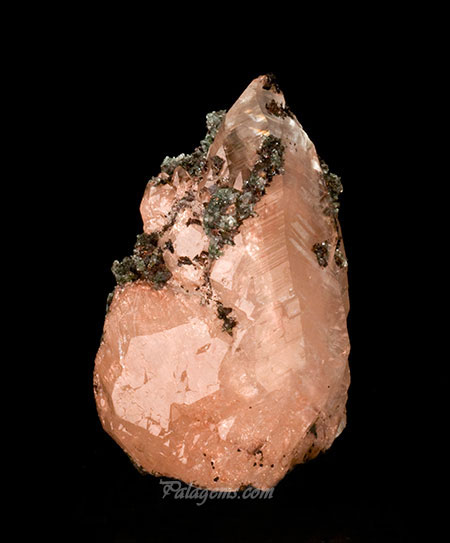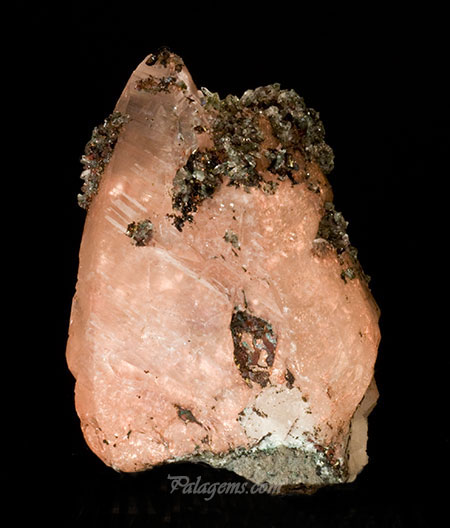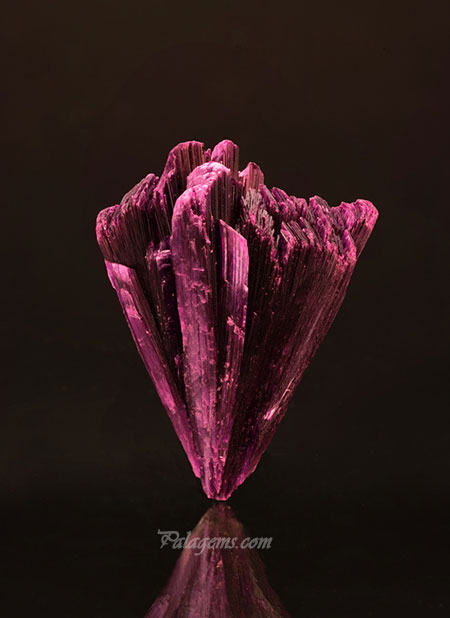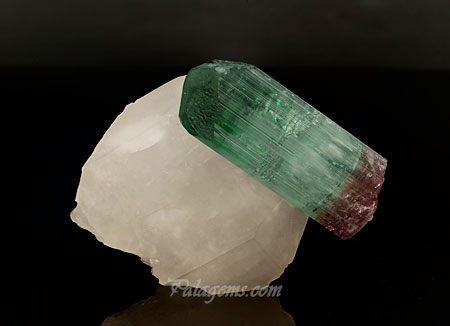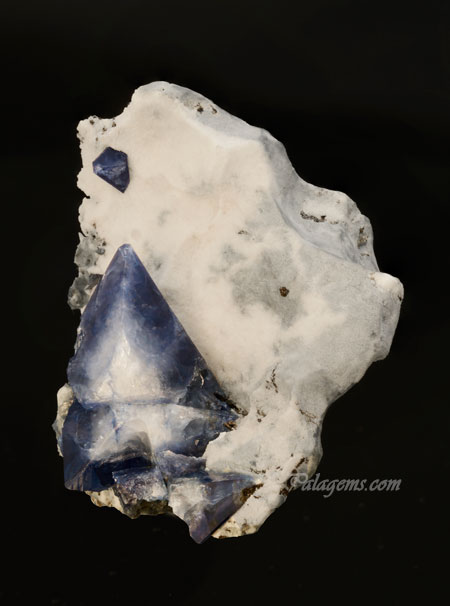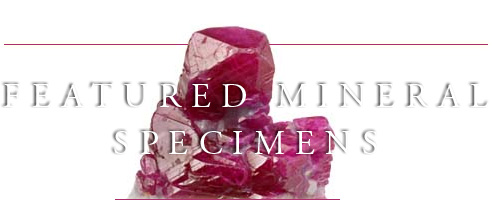
2015
Featured in Pala’s bi-monthly Mineral News. Specimens from 2014 are here. Specimens from 2012 and 2013 are here. Specimens from 2006 through 2011 are here.
October 1, 20115: Prehnite and Tanzanite from TanzaniaWith this edition of our newsletter we offer a rare and remarkable specimen of well crystallized greenish prehnite in a fine cockscomb specimen. This beautiful group was found earlier this year at the Merelani Mine, Arusha, Tanzania. To make the piece even more exciting and interesting, a well terminated bicolor (yellow and blue) tanzanite (3.0 x 2.5 cm in height) has grown into the side of this prehnite.
Interested? Call (phone numbers below) or email us to inquire. [back to top] |
August 3, 2015: "Rainbow Castle"This time we offer a goethite growing in columns with vivid iridescences sparkling with all the colors of the rainbow. The sample, from a very unique find in the 1980s, was in a Spanish private collection.
Interested? Call (phone numbers below) or email us to inquire. [back to top] |
June 2, 2015: Copper in CalcitePala International has re-acquired a calcite with copper inclusions from the Keweenaw Peninsula in Michigan. It was formerly in the collection of Ben Williams, which will be featured in an upcoming edition of Mineralogical Record. This specimen was our featured item for April 2011 and we're delighted to offer it again.
Here's the description we gave the first go-round: It has a beautiful scalehedron structure, a massive white calcite in the core and a clear outer layer including the peak of the crystal, which is transparent. The center layer is a brilliant copper phantom that scintillates in the light. With impressive size, shape and color this specimen is definitely an icon in the mineral world. No damage, no repairs, just a pristine beauty. This specimen was collected by Ben Williams’s father, John Williams, in the 1860s. During this time period the elder Williams worked at the copper smelter in Hancock, Michigan. Ben would have been a young teenager at the time. These pieces were likely passed on from father to son and pre-date Ben’s arrival at Bisbee, Arizona by about 15 years. Most of these copper-in-calcites came out in the 1800s and early 1900s. The two main mines that produced this rare blend were the Quincy Mine and the Franklin Mine around Hancock, Houghton Co., in Michigan. See more on Keweenaw Copper District in the Mar–Apr 2011 edition of Rocks & Minerals (courtesy of 2010’s Rochester Mineralogical Symposium).
Interested? Call or email us to inquire. [back to top]
CorrectionsWe don't often make mistakes, and they usually are the sort that can be corrected when the newsletter is archived on Palaminerals.com. A couple of instances come to mind. Two years ago, I mistook dendrites for fossilized ferns; historian and professional appraiser Dr. Kenneth Burchell straightened me out, as did paleontologist Alan Goldstein. In June, as part of thanking clients for their support over the past 46 years of Pala International's existence, I wrote: You keep us unspired. That gaff was caught in-house by Pala's John McLean. In our last edition of Pala Mineralis, we featured a specimen that I understood had made a 360-degree revolution since it appeared in April 2011 as that month's feature, and we were happy to offer it again. Imagine my surprise when we received a note from collector Kevin Schofield that read in part, "My intrigue is driven largely by the fact that the piece in question is sitting about ten feet from me as I speak, and has been in my possession ever since purchasing it from you in April of 2011. It also features quite nicely in the recent Texas Collectors edition from the Mineralogical Record." As is my own intrigue driven… — David Hughes, Editor [back to top] |
April 2, 2015: Erythrite from MoroccoIn this edition of our newsletter we feature an aesthetic bouquet of erythrite crystals from Morocco. The crystals are undamaged and sharp, with intense color. Great for any miniature collector!
While other examples of erythrite in the Pala International catalog are perched on matrix, this featured specimen seems to stand on its own. Its lovely crystals exhibit 'red' in all its hues. Just as rhodochrosite takes its name from the Greek rhodokhrōs (rose-colored), erythrite is from the Greek eruthros/erythros (red). Its combining form erythr- is used in many a medical term, from erythrocyte (red blood cell) to systemic lupus erythematosis (the autoimmune syndrome sometimes characterized by a red butterfly-shaped rash thought to have resembled the bite of a wolf, lupus in Latin). (Yes, your editor was a medical transcriber in a previous incarnation.) |
February 2, 2015: Classic Tourmaline and BenitoiteThis month we feature a couple of blasts from the past: two exceptional classics that define aesthetics and rarity in the mineral world. The first specimen is a well perched multi-colored tourmaline on quartz. A fine crystal on its own, this tourmaline displays brilliant pink to mint into evergreen gradation of color. It's very pristine with virtually no damage besides the base. It features an admirable complex termination with gemmy sections running throughout. This bright tourmaline is well contrasted on a nice chunk of quartz.
The second specimen is an exquisite benitoite on natrolite. The benitoite crystal itself is huge for the species, 3.5 cm in length. It features a striking trigonal crystal, but a little rough around the edges. This large crystal displays a beautiful color pattern radiating from a white core to brilliant blue edges. To top it all off the benitoite is in front of an equally striking white natrolite background, showing the ideal association of minerals from San Benito County.
|
2014
Featured in Pala’s bi-monthly Mineral News. Specimens from 2012 and 2013 are here. Specimens from 2006 through 2011 are here.
December 2014: Anglesite and Aquamarine
In this edition of our newsletter we feature two cabinet-specimen stocking-stuffers.
First, an anglesite from Monteponi Mine, Iglesias, Sardinia. This fine small cabinet specimen was found in the 1970s and purchased at this year's Munich Show from Pala international friend and French dealer Alain Martaud, who had received it from an Italian collection just weeks before the show. It is well terminated and lovely, featuring a light yellow color. This would be a very rare piece for any mine, but especially rare for this classic Italian locality.
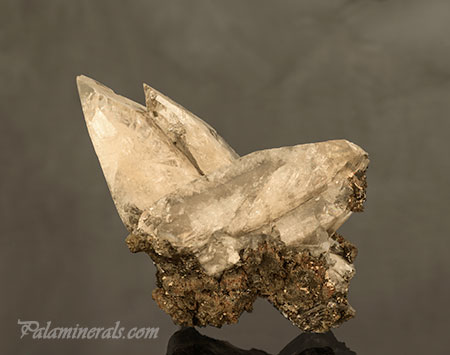 |
| Anglesite from the Monteponi Mine, Iglesias, Sardinia, Italy, 7 x 3 cm, $3000.00. (Photo: Mia Dixon) |
We also offer a fine small cabinet aquamarine matrix specimen. It features multiple, unrepaired, beautiful blue and gemmy aquamarine crystals on quartz crystal. Matrix is very hard to obtain from Vietnam's Thuong Xuan area near the Laos border. Pala International has good contacts from Vietnam via visits in the late 1990s and obtains specimens directly from Vietnamese miners through friends. For more on this locality, see "Aquamarine from the Thuong Xuan District, Thanh Hoa Province, Vietnam," Gems & Gemology, Vol. 47, No. 1 (Spring 2011).
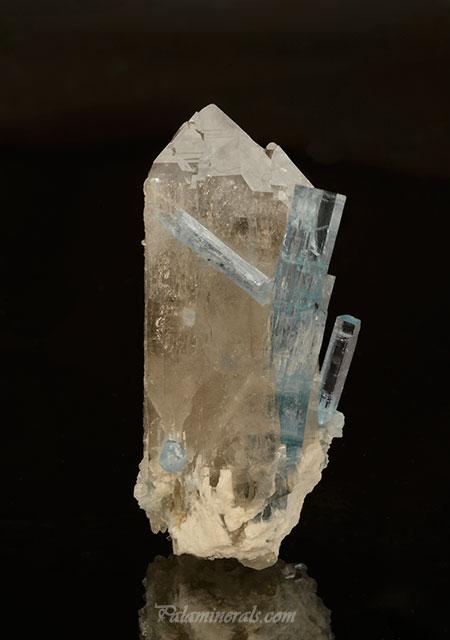 |
| Aquamarine on quartz from Thuong Xuan, Vietnam, 10 x 4.5 cm. Price available upon request. (Photo: Mia Dixon) |
Interested? Call or email us to inquire. [back to top]
October 2014: Kongsberg Silver
With this edition of our newsletter we feature a lovely silver from a classic locality: Kongsberg, Norway. It is a beautiful horn thick wire silver that has great luster and patina. These types of silvers are very hard to come by. (Might that have anything to do with the fact that Kongsberg also happens to be home to the Mint of Norway?)
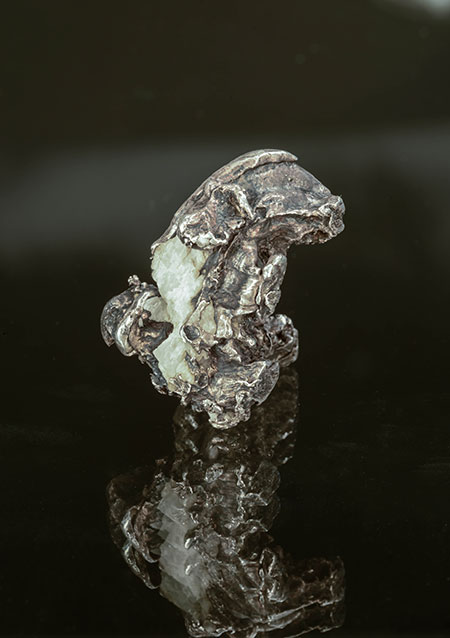 |
| Saved from the mint. Kongsberg silver. Price and other details available upon request. (Photo: Jason Stephenson) |
Interested? Call or email us to inquire. [back to top]
August 2014: Green Beryl from Brazil
This fine green beryl is from a find in Brazil dating back to the 1980s. The specimen is a beautiful cluster of doubly terminated beryls all with very fine luster and color. To have so many beryls together and in great shape is truly rare! This specimen would do well in anyone's beryl collection or world-wide collection as well.
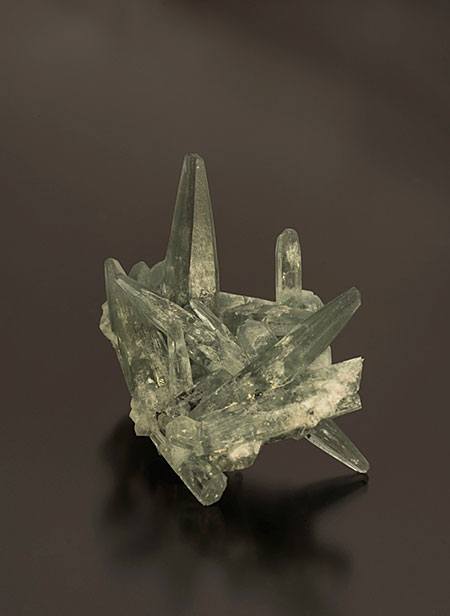 |
| Green beryl from the Mimoso do Sul Mine, Espirito Santo, Brazil, 6 x 4 x 4.5 cm. Price available upon request. (Photo: Mia Dixon) |
Interested? Call or email us to inquire. [back to top]
June 2014: Specimens from Afghanistan and Colombia
With this edition of our newsletter we feature two specimens from opposite ends of the earth.
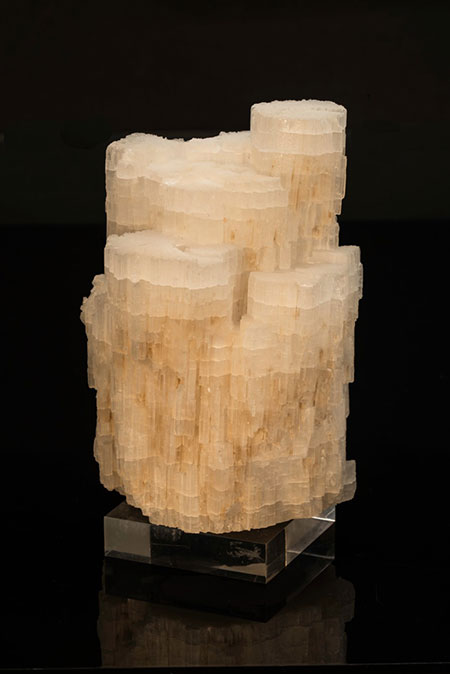 |
| Beryllonite, a rare species, from Afghanistan, 11.5 x 7.5 cm. Price available upon request. (Photo: Mia Dixon) |
We lead off with a great rarity—a large, double-terminated, very complex beryllonite from Paprok, Nuristan Province, Afghanistan. This is a specimen for an advanced collector or museum.
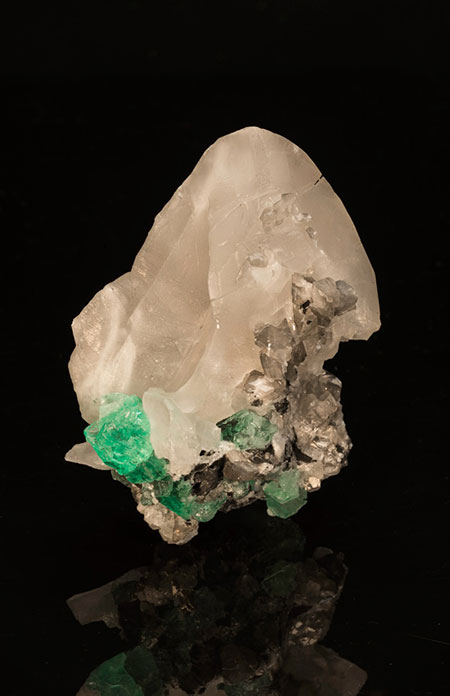 |
| Calcite with emerald, 8 x 6 x 3 cm, from Colombia, $6500. (Photo: Mia Dixon) |
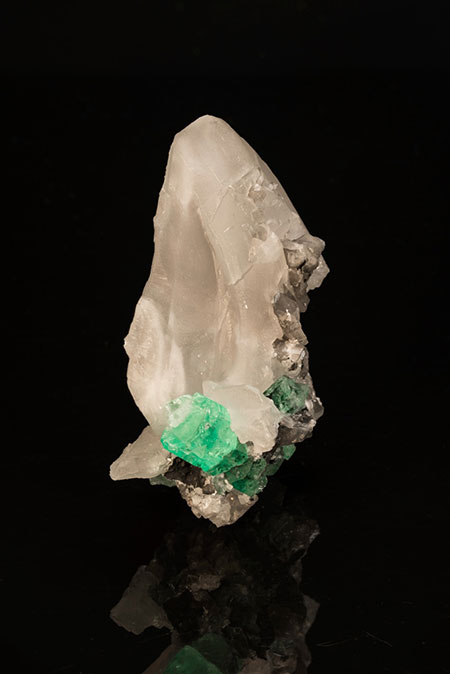 |
We call our second featured specimen "The Emerald Sail Ship," with its concave calcite catching the ocean's air. This is an aesthetic, large calcite crystal with no damage and a lively green emerald crystal attached at the bottom. The emerald has a fine, etched termination that adds to its beauty. The sail hails from the locality of La Pita Mine in La Pita, Mun. de Maripí, Vasquez-Yacopí Mining District, Boyacá Department, Colombia.
Interested? Call or email us to inquire. [back to top]
April 2014: Chrysoberyl Twin from Brazil
This month’s featured mineral is a chrysoberyl twin that dates back to the 1970s when they hit one large pocket full of great specimens like this very one. The surface of the crystal has very nice striations and the transparency can be seen in the tips of it. This V-twin chrysoberyl is quite large for the species and is in very good shape with no damage. A prize for any major collector!
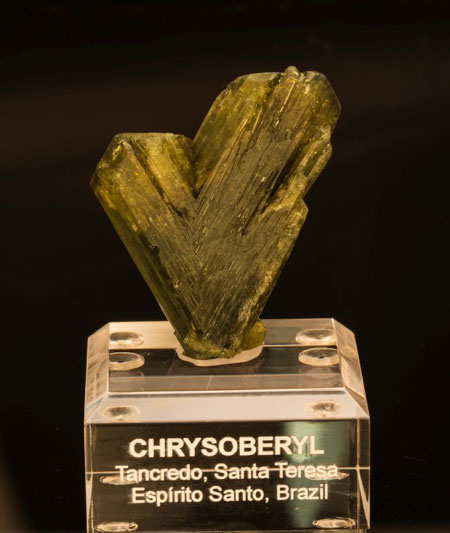 |
| Chrysoberyl twin from Tancredo, Santa Teresa, Espíritu Santo, Brazil; 6 cm x 4.4 cm x 2.2 cm. Price available upon request. (Photo: Mia Dixon) |
Interested? Call or email us to inquire. [back to top]
February 2014: Rough & Cut Diopside
On our way out the door and on the road to Tucson, we feature a rare and beautiful green gem. Diopside ranges from brown to yellow to olive green to intense green. This month we feature a couple of stunning cut diopsides from Burma. The larger yellow cushion is 17.45 carats and the smaller green one is 4.90 carats. These gems are paired with an exceptional evergreen crystal from China, measuring 5.5 x 2.5 x 2.5 cm.
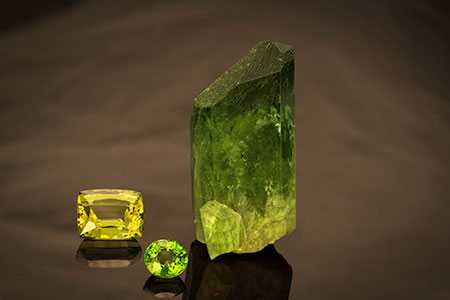 |
| Green jewels from the Larsons’ collection. Click to enlarge. (Photo: Mia Dixon) |
Interested in something along this line? Call (telephone numbers below) or email us to inquire. And see us in Tucson. [back to top]
2013
December 2013: Makalu Quartz
This month we feature a stunning quartz cluster from Nepal.
This eloquent assemblage of quartz shows the best from Nepal: sharp, clear and pristine crystals. To top it all off is a superb Japan-law twin perched right in the center of this complex specimen. One side of the twin actually penetrates the largest vertical crystal. Compounding beauty and rarity.
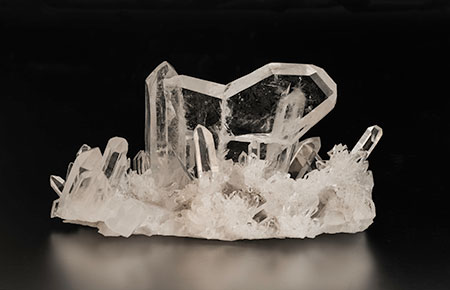 |
| Makalu Quartz from Sankhuwasabha District, Kosi Zone, Nepal, 11.5 x 5 x 5.5 cm. Price available upon request. Click to enlarge. (Photo: Mia Dixon) |
This unique specimen is from a quartz mine in the Makalu Mountain area, somewhere between Gunyahang and Sabhapokhari Mountain. Also referred to as Jaljale Himal, Sankhuwasabha district, Eastern Nepal. This deposit lies at 12,175 feet and requires climbing a pass that reaches 14,500 feet.
Interested? Select the inventory number above, call (telephone numbers below) or email us to inquire.
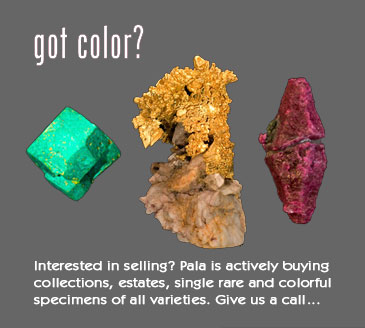 |
[back to top]
October 2013: Dioptase from Namibia
This month’s featured mineral is your chance to pick up a rare and hard-to-find specimen that has beautiful green crystals of dioptase sitting on white calcite. The dioptase is damage-free with top luster and it is also a great cabinet size.
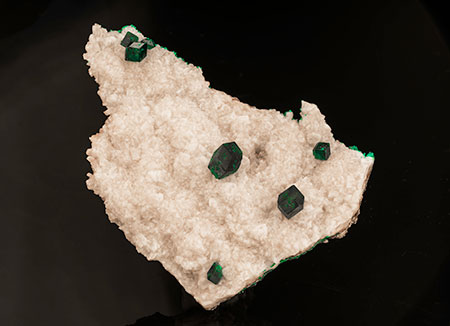 |
| Dioptase from the Tsumeb Mine, Namibia, measuring 12 x 8.5 x 2.5 cm. Click to enlarge. (Photo: Mia Dixon) |
Dioptase from Tsumeb is regarded as one of the holy grails for mineral collectors. Out of all the locations in the world the stark contrast of the beautiful green crystals sitting on white calcite tends to outdo many dioptases from other localities. Please contact us for any inquiries on this piece as well as price.
Interested? Select the inventory number above, call (telephone numbers below) or email us to inquire. [back to top]
August 2013: Scorodite on Quartz
When Spanish conquistadors penetrated into the interior of the land now called Mexico, they found a region rich in silver. In fact, the city of Zacatecas, in the southeast part of the state that today bears the same name, originally was called Minas de los Zacatecas. (Zacateca has its roots in a Spanish rendering of the region, taken from Nahuatl word for “reed,” “grass” or “straw”: zacatl.) The mines were so productive they were second only to those of Potosí, Bolivia. The immense amount of silver contributed to, and virtually created, the money economy of Europe at the time. In his 1988 book Indian Givers: How the Indians of the Americas Transformed the World, anthropologist Jack Weatherford, citing historian Fernand Braudel, wrote that in the first fifty years of the conquest (four years before the Spaniards found the riches of Zacatecas in 1546) already 16,000 tons of silver had passed into Seville’s port—about $10 billion in today’s market. Weatherford stated that Potosí “rivaled such Old World cities as London and Paris in size.” Zacatecas was second in size only to Mexico City, during New Spain’s colonial period. Much wealth left for Europe, but enough remained to allow Zacatecas to build its own fine examples of Spanish Baroque architecture. The city’s cathedral is remarkable for its integration of indigenous designs in the stonework of what otherwise is a 17th century church. The state of Zacatecas also is home to native architecture such as La Quemada (“the burned” city), referred to by one tourism site as “Pre-Colombian precious stones.”
Northeast of Zacatecas (the capital) is the municipality of Concepción del Oro, named due to the other precious metal found in the region—gold. The locality also is noted for varieties of quartz. Sometimes the quartz sports a little something extra, as in our featured mineral specimen.
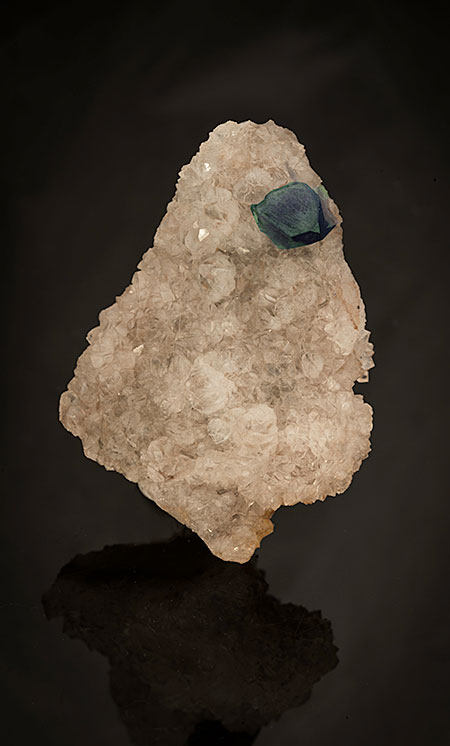 |
| Scorodite on quartz, 5.2 x 4.0 x 2.5 cm, from El Cobre Mine, Zacatecas, Mexico. Price available upon request. Click to enlarge. (Photo: Mia Dixon) |
This specimen displays a complex of quartz crystals topped by a single dipyrimidal crystal of scorodite, an ester of arsenic. The name comes from scorodion, Greek for “garlicy,” the odor released when the material is heated. (Don’t try this at home, kids…) The specimen hails from El Cobre Mine—Spanish for “copper.”
Interested? Select the inventory number above, call or email us to inquire. [back to top]
June 2013: Tanzanite
This month’s featured specimen is a fine Tanzanite crystal that has great character with the small tanzanite crystal sidecar. Most of the back and edges of the specimen are encrusted with a fine white calcite, which is quite rare even though calcite is a fairly common associate mineral in the mine. Bring it home with you!
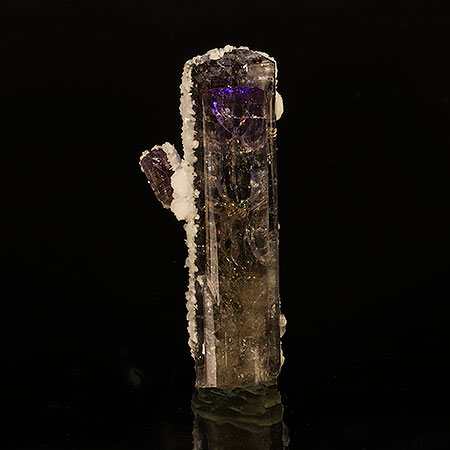 |
| Tanzanite from Merelani, 7 x 3 x 1.5 cm. Inventory #20963. (Photo: Mia Dixon) |
Interested? Select the inventory number above, call (telephone numbers below) or email us to inquire.
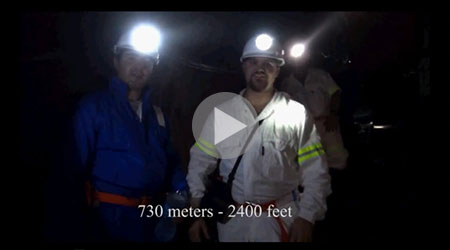 |
| If you missed it last year, see Will Larson’s First Voyage to Tanzania – Tanzanite – A Stone of Beauty on Pala International’s YouTube channel. See also Will’s written report on The Arusha International Gem, Jewelry and Minerals Fair, held in Arusha, Tanzania. |
[back to top]
April 2013: Peridot from Pakistan and Benitoite from California
Our first feature hails from the great peridot-producing region of Kohistan, North-West Frontier Province, Pakistan—more specifically, the Supatt Mine. This area has produced a wide variety of material, from fine faceted stones to large crystals. Before Pakistan came online, large euhedral peridot crystals were extremely rare, mainly from Burma, but now we have more production coming from Pakistan. These rich deposits have only been producing fine specimens for 12–15 years and rival other localities as far as size, form, and numbers. This month’s feature is even more rare than the average single crystal. We have one large euhedral gemmy crystal situated at the end of a massive peridot matrix. It has a very aesthetic and intense green, with a little cluster of magnetite positioned in the bottom joint of the S-curve.
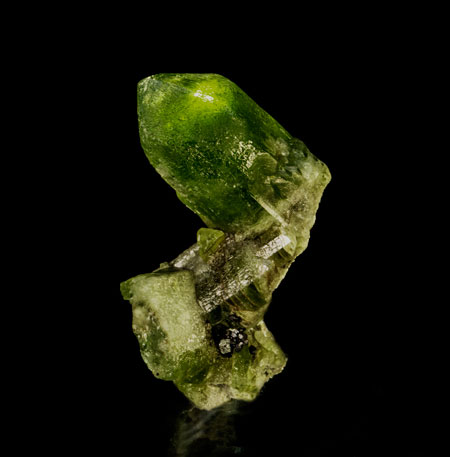 |
| Peridot crystal, 6 x 4.5 x 2.5 cm. Inventory #20962. (Photo: Jason Stephenson) |
Our second feature is a stunning plate of razor-sharp benitoite crystals on a white natrolite and gray crossite matrix. It contains a couple dozen trigonal benitoites, ranging from white through sapphire blue, with some points almost black with intensity. There are even a few tiny joaquinite crystals scattered around. Benitoites haven’t really been mined properly in San Benito County (CA) in over a hundred years, but every once in a while collectors will liquidate some of their stash and we see a few fine pieces trickle out into the market. This piece is an exceptional small cabinet-size specimen.
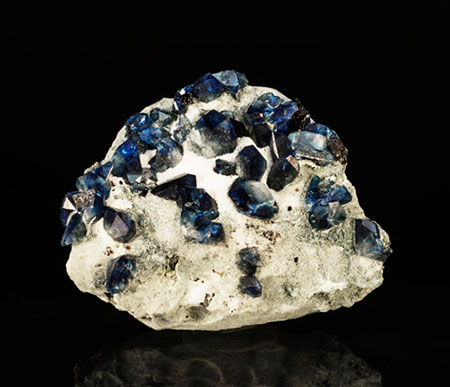 |
| Benitoite specimen, 7 x 5 x 3 cm. Inventory #20961. (Photo Jason Stephenson) |
Interested? Select the inventory numbers above, call or email us to inquire. [back to top]
February 2013: Fluorite from Russia
In accordance with this year’s Tucson Gem & Mineral Show we feature a clear fluorite from Russia. This fluorite is from Dal’negorsk, Primorskij Kraj, Russia, a classic locality for many fine, rare minerals.
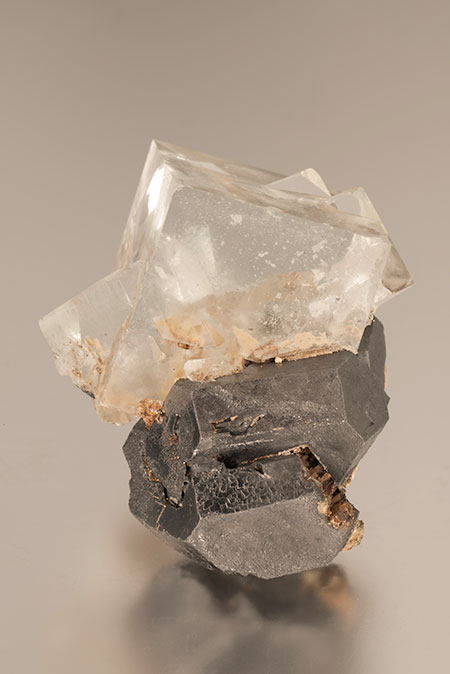 |
| Fluorite & Galena from Dal’negorsk, 7 x 5.4 x 5 cm. (Photos: Mia Dixon) |
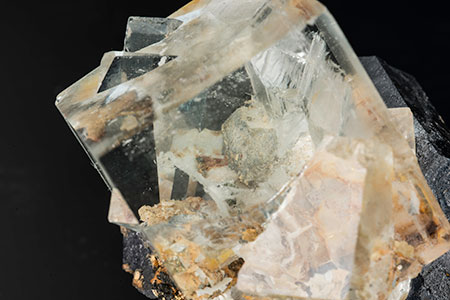 |
This ice cube-like fluorite is crystal clear with a couple of phantoms inside and several penetrating secondary cubes. It’s a very pristine cluster with virtually no damage. The specimen is highly elevated by a massive galena crystal as the matrix: one large, complex euhedral galena with a couple of smaller ones on the bottom. There is a trace of chalcopyrite running through the base as well. This is a stunning specimen with the great contrast of metal and ice, also quite a heavy piece—another property that is quite appealing when held.
This piece is not for sale individually; it is part of a large Russian collection that Pala has been putting together in ernest since 1994. The collection also includes museum pieces exchanged in the 1970s from institutions such as the Smithsonian and École des Mines de Paris (ParisTech).
Interested? Call or email us to inquire. [back to top]
2012
Featured in Pala’s bi-monthly Mineral News. Previous specimens from 2006 through 2011 are here.
December 2012: Aquamarine from Pakistan and Kunzite from Afghanistan
This month we feature a pair from Pakistan and Afghanistan. From the western front of the Himalaya Mountains we find a couple of exquisite crystals still carrying a chunk from the host rock.
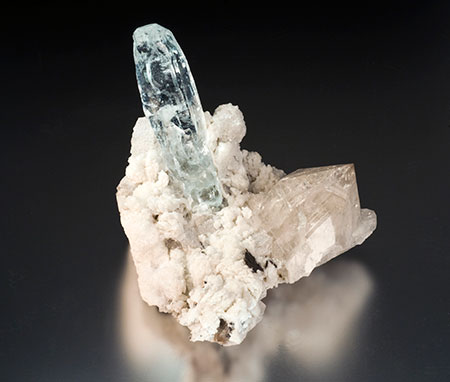 |
| Etched aquamarine, 12 x 10.5 x 10 cm. Price available upon request. (Photo: Mia Dixon) |
This aquamarine is like a prismatic glacier poised in a bed of cleavelandite and accompanied by a quartz point. There are a of couple traces of pink apatite and possibly tantalite on the specimen as well. This aquamarine exsolved from its original form to its current etched shape, leaving a pastel-blue, gemmy, ice-like sculpture. This oddity comes to us from Shigar Valley, Pakistan.
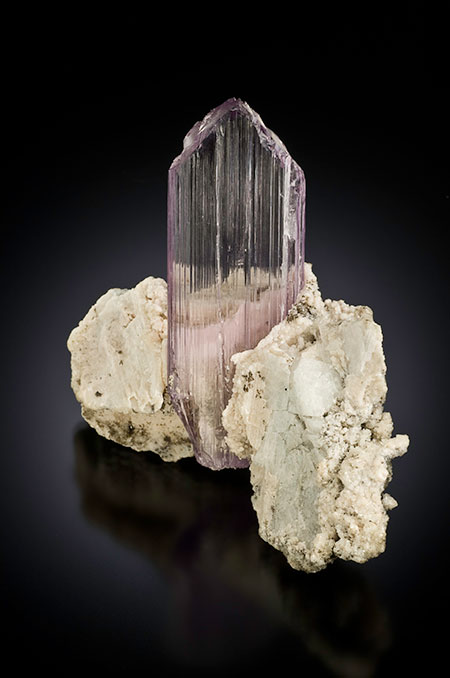 |
| Kunzite in matrix, 7.3 x 5.5 x 7.4 cm. Price available upon request. (Photo: Jeff Scovil) |
Just across the border, in Afghanistan, we find this classic pink prismatic kunzite crystal still wrapped in the pegmatite host. It’s a classic lilac kunzite blade over 7 cm and very gemmy. It is quite a rare find to see kunzite still attached to the matrix; almost all of the specimens seem to be loose single crystals. A choice specimen for gem crystal collectors, from the Pech, Konar Province, Afghanistan.
Interested? Call (telephone numbers below) or email us to inquire. [back to top]
October 2012: Fluorite from Illinois
This month we feature a beautiful single crystal of blue fluorite showcasing a nice purple phantom inside. In the center of the piece, when lit from the bottom as seen below, the fluorite has a wonderful yellow-orange core. The complex surface of the fluorite has nice luster and the piece overall has little damage.
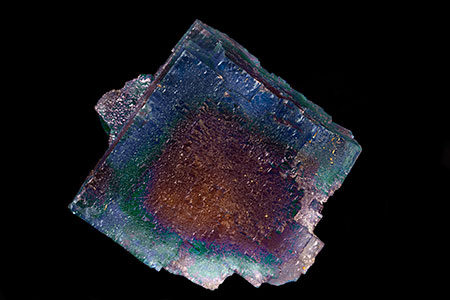 |
| Fluorite from the Minerva #1 Mine in Hardin County, Illinois, 8 cm x 7 cm x 5 cm. Below, specimen was back-lit using fiber-optic lighting. Price available upon request. (Photo: Mia Dixon) |
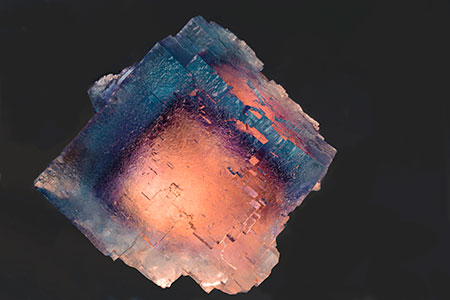 |
Interested? Call (telephone numbers below) or email us to inquire. [back to top]
August 2012: No specimen was featured at this time.
June 2012: Tanzanite from Arusha, Tanzania
This time we feature unusual fan-shaped crystals. These tanzanites have some of the most fun crystallography, which is why we had to bring them home from Tanzania on our recent trip there!
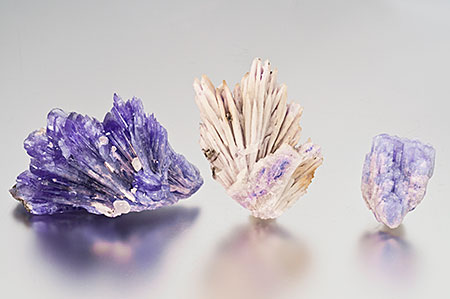 |
| Fan fanatic. Tanzanite from Mererani (Merelani), Arusha Region, Tanzania. Left to right, 6.5 x 3.7 x 3.2 cm, 5.2 x 4 x 2.1 cm, and 3 x 2.4 x 2.7 cm. Click to enlarge. Prices available upon request. (Photo: Mia Dixon) |
Bill and Will Larson attended the Arusha International Gem, Jewelry and Minerals Fair in Tanzania in April. Time allowing, Will Larson plans a report on the show for our colored gemstone e-newsltter, Palagems Reflective Index, which should go out on Flag Day, June 14.
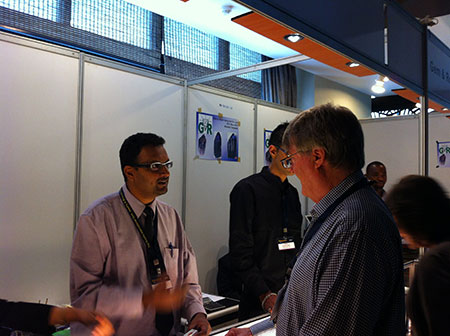 |
| Bill Larson, right, talks tanzanite with a dealer at the show. (Photo: Will Larson) |
Interested? Call or email us to inquire. [back to top]
April 2012: Rhodochrosite from Peru
This month we offer a piece from Peru. This fine rhodochrosite is covered with many rhombohedral crystals that are undamaged. The crystals are a bright and happy pink. For the locality—the Manuelita Mine of Morococha District—this piece is quite special for its size. Turning the piece onto its back reveals the rhombohedral crystals growing on top of botryoidal rhodochrosite, giving it a round shape.
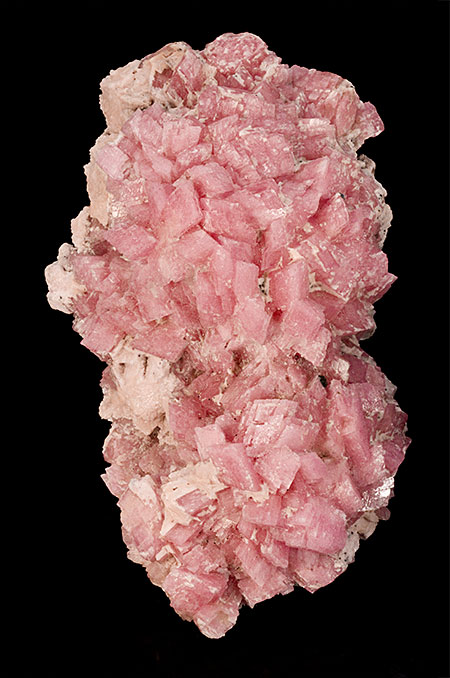 |
| Rhodochrosite from Peru, 11 x 6.5 x 3.5 cm. From the Manuelita Mine, Morococha District, Yuali Province, Junín Department. (Photo: Mia Dixon) |
Interested? Call (telephone numbers or em ail us to inquire. [back to top]
February 2012: Azurite from Arizona
To honor the theme of this year’s TGMS, we exhibit an exquisite azurite crystal from the Bisbee Mine in Arizona. Since we are all halfway out the door, headed to Tucson, not much time to embellish on the specimen. This beauty pretty much speaks for itself. Enjoy, and we’ll see you all at the TGMS and Westward Look Show.
 |
| Arizona azurite. Azurite blade with some malachite replacement. Bill Larson Collection. Price: $3,000 net. Photo: Jeff Scovil, who will conduct a mineral photography seminar at TGMS on February 9 (details here). |
Interested? Call or email us to inquire. [back to top]
Previous specimens from 2006 through 2011 are here.
